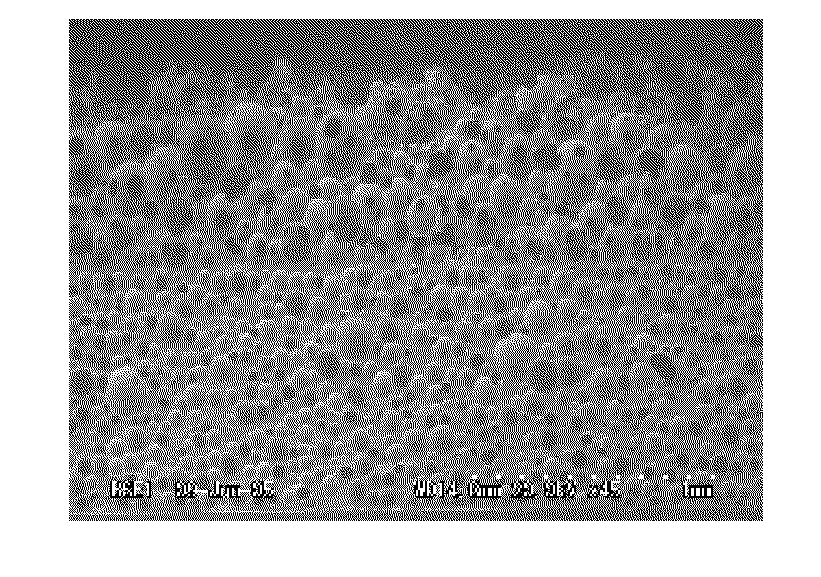Method for manufacturing a polishing pad
a polishing pad and manufacturing method technology, applied in the field of polishing pads, can solve the problems of high production cost, high environmental burden, polishing pads for finishing, etc., and achieve the effect of excellent durability and polishing speed stability, and easy manufacturing of polishing pads
- Summary
- Abstract
- Description
- Claims
- Application Information
AI Technical Summary
Benefits of technology
Problems solved by technology
Method used
Image
Examples
example 1
[0075]45 parts by weight of POP36 / 28 (polymer polyol, hydroxy value 28 mg KOH / g, made by Mitsui Chemicals, Inc.), 40 parts by weight of ED-37A (polyether polyol, hydroxy value 38 mgKOH / g, made by Mitsui Chemicals, Inc.), 10 parts by weight of PLC305 (polyester polyol, hydroxy value 305 mg KOH / g, made by Daicel Chemical Industries, Ltd.), 5 parts by weight of diethylene glycol, 5.5 parts by weight of a silicon-based surfactant (SH-192, made by Toray Dow Corning Silicone Co., Ltd.) and 0.25 part by weight of a catalyst (No. 25, made by Kao Corporation) were introduced into a container and sufficiently mixed. Then, the mixture was stirred vigorously for about 4 minutes at a revolution number of 900 rpm by a stirring blade so as to incorporate bubbles into the reaction system. Thereafter, 31.57 parts by weight of Millionate MTL (made by Nippon Polyurethane Industry Co., Ltd.) were added thereto and stirred for about 1 minute to prepare a cell dispersed urethane composition A.
[0076]The p...
example 2
[0077]POP36 / 28 (45 parts by weight), ED-37A (37.5 parts by weight), PCL305 (10 parts by weight), 7.5 parts by weight of diethylene glycol, SH-192 (5.6 parts by weight), 0.5 part by weight of carbon black, and 0.22 part by weight of a catalyst (No. 25) were introduced into a container and mixed. Then, the mixture was stirred vigorously for about 4 minutes at a revolution number of 900 rpm by a stirring blade so as to incorporate bubbles into the reaction system. Thereafter, Millionate MTL (38.8 parts by weight) were added thereto and stirred for about 1 minute to prepare a cell dispersed urethane composition B.
[0078]A polishing pad was prepared in the same manner as in Example 1 except that the cell dispersed urethane composition B was used in place of the cell dispersed urethane composition A. When a section of the polishing pad was observed under a microscope, roughly spherical interconnected cells had been formed in the polyurethane foamed layer (average cell diameter, 66 μm; mean...
example 3
[0079]POP36 / 28 (45 parts by weight), ED-37A (35 parts by weight), PCL305 (10 parts by weight), 10 parts by weight of diethylene glycol, SH-192 (6.2 parts by weight), 0.5 part by weight of carbon black, and 0.2 part by weight of a catalyst (No. 25) were introduced into a container and mixed. Then, the mixture was stirred vigorously for about 4 minutes at a revolution number of 900 rpm by a stirring blade so as to incorporate bubbles into the reaction system. Thereafter, Millionate MTL (46.04 parts by weight) were added thereto and stirred for about 1 minute to prepare a cell dispersed urethane composition C.
[0080]A polishing pad was prepared in the same manner as in Example 1 except that the cell dispersed urethane composition C was used in place of the cell dispersed urethane composition A. When a section of the polishing pad was observed under a microscope, roughly spherical interconnected cells had been formed in the polyurethane foamed layer (average cell diameter, 75 μm; mean ma...
PUM
| Property | Measurement | Unit |
|---|---|---|
| average cell diameter | aaaaa | aaaaa |
| Ra | aaaaa | aaaaa |
| average particle diameter | aaaaa | aaaaa |
Abstract
Description
Claims
Application Information
 Login to View More
Login to View More - R&D
- Intellectual Property
- Life Sciences
- Materials
- Tech Scout
- Unparalleled Data Quality
- Higher Quality Content
- 60% Fewer Hallucinations
Browse by: Latest US Patents, China's latest patents, Technical Efficacy Thesaurus, Application Domain, Technology Topic, Popular Technical Reports.
© 2025 PatSnap. All rights reserved.Legal|Privacy policy|Modern Slavery Act Transparency Statement|Sitemap|About US| Contact US: help@patsnap.com


